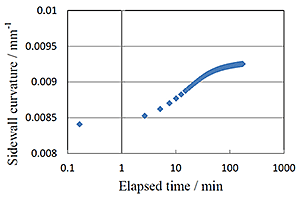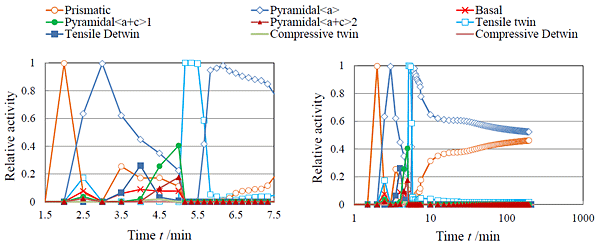Commercially-pure titanium (CP-Ti) sheets are widely used in industrial products because of their characteristics such as high specific strength and corrosion resistance. Because CP-Ti sheets exhibit strongly anisotropic deformation behavior due to their hexagonal-close-packed (hcp) structure and strong basal texture, their deformation behaviors have been extensively studied from both macroscopic and microscopic viewpoints.
It was reported that some metallic sheets exhibit the so-called time-dependent springback at room temperature. Wang et al. reported that in an aluminum sheet the amount of springback gradually increases with the elapsed time after unloading. Similar behavior was also observed in magnesium alloy and advanced high-strength steel sheets. Hereafter this phenomenon is called elapsed time-dependent springback. Kyuno et al. conducted a draw-bending test using a steel sheet and showed that the amount of springback decreased as the holding time before unloading increased. This phenomenon is hereafter called holding time-dependent springback. The holding and elapsed time-dependent springback were considered to result respectively from stress relaxation that occurs during holding and from creep driven by residual stresses after unloading. Because it has been recognized that CP-Ti sheets show pronounced viscoplastic deformation behavior at room temperature, we examined time-dependent springback of a CP-Ti sheet experimentally and found that a CP-Ti sheet also showed pronounced holding and elapsed time-dependent springback. Although the deformation mechanism was discussed with respect to stress relaxation and creep, the discussion was only phenomenological and qualitative; thus, the detailed mechanism is still open to discussion.
In this study, a crystal plasticity finite-element method is used to examine elapsed time-dependent springback of a CP-Ti sheet. A two-dimensional draw bending process is simulated by using a crystal plasticity finite-element method, and the deformation mechanism at the mesoscopic level is discussed.
Figure 1 shows the relationship between the curvature and the elapsed time after unloading. The curvature increased with the elapsed time. The increase in curvature from 5 min to 100 min was approximately 7 %. These results are in qualitatively good agreement with the experimental results of a grade 2 CP-Ti sheet although the increasing rate was larger in the simulation.
Focusing on an integration point near the surface on the die side, the evolutions of relative activities and stress components in the co-rotational frame as a function of time are respectively shown in Figs. 2 and 3. In Fig. 3, x’ and y’ denote respectively the longitudinal and thickness directions of the sheet. Only the components in the x’ - y’ plane are shown. When the integration point was subjected to compression in the longitudinal direction due to bending at the die shoulder ( t > 2 ), pyramidal <a> slip, {1012} twinning, basal slip, and prismatic slip were active. Thereafter the loading direction was inverted to tension because of unbending ( t > 2.5 ). After σx’x’ turned to positive, {1012} detwinning was active in addition to pyramidal <a> slip and prismatic slip. As the activity of {1012} detwinning decreased sharply, the activities of two types of pyramidal <a+c> slip increased. The aforementioned evolution is very similar to that observed during uniaxial reverse loading from compression to tension. Thereafter, during unloading ( 5 ≤ t ≤ 7.5), the activity of {1012} twinning was dominant initially, but it suddenly decreased and, alternatively, the activity of pyramidal <a> slip rapidly increased. The activity of pyramidal <a> slip then decreased gradually, while the activity of prismatic slip gradually increased. {1012} twinning was also active to a small extent. These slip and twinning systems were active during unloading because of the heterogeneous stress distribution at the grain level. Further, these three slip and twinning systems kept on activating even after the integration point was macroscopically unloaded from the tools ( t > 7.5 ). The slip and twinning activities after unloading would be driven by the residual stresses because non-negligible residual stresses remained after unloading, resulting in the increase in the curvature with the elapsed time. Interestingly, the mechanism of the plastic deformation that occurred after unloading would be very similar to that of creep because the residual stresses remained almost constant or decreased very gradually. This result supports the hypotheses reported in previous studies.


